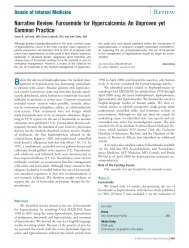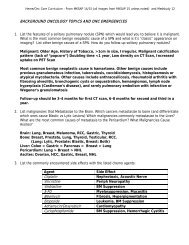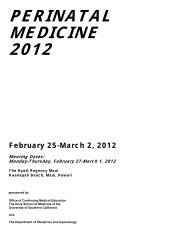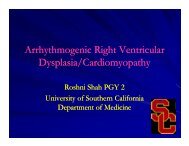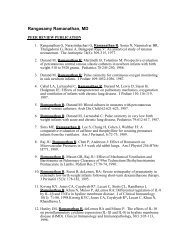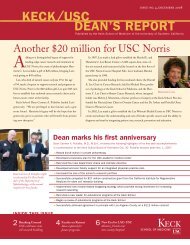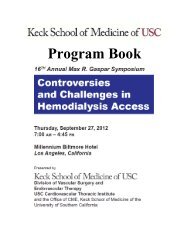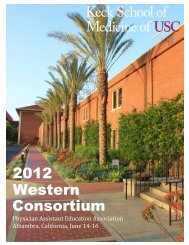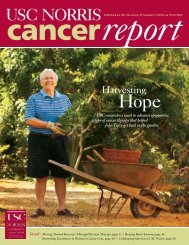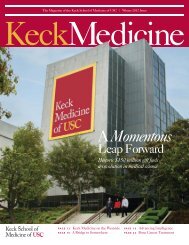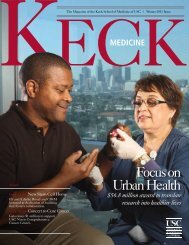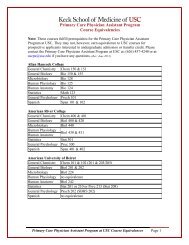Infectious Diseases - Keck School of Medicine of USC - University of ...
Infectious Diseases - Keck School of Medicine of USC - University of ...
Infectious Diseases - Keck School of Medicine of USC - University of ...
- No tags were found...
Create successful ePaper yourself
Turn your PDF publications into a flip-book with our unique Google optimized e-Paper software.
<strong>Infectious</strong> <strong>Diseases</strong>The Division <strong>of</strong> <strong>Infectious</strong> <strong>Diseases</strong> aims to 1) advance the frontier <strong>of</strong> medical science through clinical and translational research ininfectious diseases, 2) promote excellence in the education <strong>of</strong> medical students, house <strong>of</strong>ficers and clinical fellows, and 3) delivercompassionate, evidence-based, state-<strong>of</strong>-the-art care to a large, diverse, multicultural community <strong>of</strong> Southern California.OVERVIEW OF ACHIEVEMENTSResearch: The Division continues to provide scientific leadership in a wide range <strong>of</strong> research. The Division maintains consistent funding forongoing investigations relating to both HIV and other areas <strong>of</strong> infectious diseases. The Division has had an important and productive role inlarge, multicenter collaborative research groups that emphasize development <strong>of</strong> treatment and prevention modalities for HIV infection andcomplications associated with antiretroviral therapy and the underlying disease.Our NIH-supported AIDS Clinical Trials Unit (CTU Fred R. Sattler, M.D., Principal Investigator) is a major focus <strong>of</strong> research in the Division.The CTU received a notice <strong>of</strong> grant award in June 2007 that it would be fully funded for an additional seven years. The <strong>USC</strong> CTU has beenone <strong>of</strong> the most productive units in the United States over the past two decades. During this 22-year span, the CTU has performed at a veryhigh level and has been second in enrollment <strong>of</strong> total research subjects in AIDS Clinical Trial Group (ACTG) studies and is the leadingsite in the continental U.S. for enrolling minorities. Moreover, key personnel on the grant at <strong>USC</strong> hold a number <strong>of</strong> important scientificand administrative leadership positions in the ACTG, including the Executive Committee (Dr. Fred Sattler), Optimization <strong>of</strong> AntiretroviralTherapies (Dr. Michael Dube), Translational Research and Drug Development (TRADD) Committee (Dr. Stan Louie, <strong>School</strong> <strong>of</strong> Pharmacy)and the Underrepresented Populations Committee (Dr. Alejandro Sanchez). In addition, Dr. Robert Larsen is co-chair <strong>of</strong> a large internationalstudy <strong>of</strong> Cryptococcal meningitis. These key positions have enabled faculty from our Division to contribute to and facilitate the scientificagenda and productivity <strong>of</strong> this world-leading HIV collaborative treatment group.The Division remains an active member <strong>of</strong> the California Collaborative Treatment Group (CCTG), which is in its 22nd year and is funded bythe State <strong>of</strong> California <strong>University</strong>-Wide AIDS Program with monetary backing from the California State Legislature. Dr. Larsen continues toprovide a leading role for <strong>USC</strong> in this effort and is Principal Investigator for the <strong>USC</strong> site.Dr. Larsen is the Principal Investigator for an NIH investigator-initiated grant to test novel methods to determine the susceptibility <strong>of</strong>cryptococcus ne<strong>of</strong>ormans to antifungal drugs alone and in combination.Under the principal leadership <strong>of</strong> Dr. Brenda Jones, <strong>USC</strong> has been a leading performance site in the Centers for Disease Control andPrevention-funded multicenter collaborations studying therapeutics and prevention <strong>of</strong> tuberculosis (Tuberculosis Trials Consortium). Dr.Jones also received a 5-year NIH subcontract with the <strong>University</strong> <strong>of</strong> California San Diego through October 2008 to establish a National TBCurriculum Center.Dr. Anne Anglim has served as the local Principal Investigator <strong>of</strong> the GeoSentinel Global Surveillance Network sponsored by the CDC and theInternational Society <strong>of</strong> Tropical <strong>Medicine</strong> to determine surveillance and to track emerging patterns (prevalence and incidence) <strong>of</strong> importantmicrobial pathogens acquired by travelers. GeoSentinel is constituted by an international network <strong>of</strong> 41 (16 in the U.S.) travel and tropicalmedicine clinics (one <strong>of</strong> which is located at <strong>USC</strong>) to detect geographic and temporal trends in infectious complications and other morbidities intravelers, immigrants and refugees. She works with other faculty and clinical fellows in the ID Division to provide regular reports <strong>of</strong> sentinelinfections amongst these populations at LAC+<strong>USC</strong> Medical Center and <strong>USC</strong> <strong>University</strong> Hospital.Finally, Dr. Sattler is Principal Investigator <strong>of</strong> a National Institute <strong>of</strong> Aging multicenter clinical and translational investigation to assess theeffects <strong>of</strong> the hypothalamic-pituitary gonadal and hypothalamic-pituitary-IGF-1 axes in regulating muscle protein synthesis and breakdown inolder persons at risk for sarcopenia and frailty. This study is funded by the National Institute <strong>of</strong> Aging and deemed by a panel reporting to theInstitute <strong>of</strong> <strong>Medicine</strong> as one <strong>of</strong> five important national studies that will provide the basis and financial justification for the conduct <strong>of</strong> a largemulticenter study (under Dr. Sattler’s guidance <strong>USC</strong> will participate in the planned study) to determine the safety <strong>of</strong> testosterone replacementtherapy for prostate and cardiovascular health in older men.These faculty and others also conduct additional investigator-initiated mechanistic and clinical research outside the structure <strong>of</strong> thesemulticenter trials and are funded by the NIH and other peer-reviewed funding agencies.Major Patient Care Service ResponsibilitiesRand Schrader HIV Clinic: The <strong>Infectious</strong> <strong>Diseases</strong> Division maintains responsibility for the medical operations <strong>of</strong> the Rand Schrader HIVClinic, operated under the auspices <strong>of</strong> the Los Angeles County-<strong>University</strong> <strong>of</strong> Southern California (LAC+<strong>USC</strong>) Medical Center. Dr. JosephCadden serves as the Medical Director <strong>of</strong> the Clinic and is responsible for the day-to-day operations <strong>of</strong> the Clinic in consultation with Dr.Sattler. This modern free-standing, 3-story, 33,000-square-foot facility is dedicated to the comprehensive care <strong>of</strong> persons infected with HIVand features faculty physicians from the Division and other specialties in the Department <strong>of</strong> <strong>Medicine</strong> as well as other departments who serveas consultants to provide specialty care, primary care providers, supervisors <strong>of</strong> physician extenders, and attending physicians for interns,residents, and fellows. Approximately 50 <strong>USC</strong> faculty members work in the clinic each week to provide comprehensive state-<strong>of</strong>-the-art carefor patients afflicted with HIV.134 <strong>University</strong> <strong>of</strong> Southern California Department <strong>of</strong> <strong>Medicine</strong>
Patients are referred to the Rand Schrader HIV Clinic from the LAC+<strong>USC</strong> Medical Center, as well as from outside clinics, agencies andproviders. The Clinic is open for morning and afternoon sessions Monday through Friday, with an additional Tuesday evening session, andreports approximately 3,000 monthly patient visits. This Clinic serves as a critical conduit with the Los Angeles County Department <strong>of</strong> Healthfor tracking patients also infected with tuberculosis.In addition to HIV-AIDS primary care, the outpatient <strong>Infectious</strong> <strong>Diseases</strong> Referral Clinic holds a morning session each week in the RandSchrader Clinic Building. <strong>Infectious</strong> <strong>Diseases</strong> faculty and fellows, as well as internal medicine housestaff and medical students rotating on the<strong>Infectious</strong> <strong>Diseases</strong> Consult Service, staff this clinic each week.Hospital Infection Control: Dr. Paul Holtom serves as the Hospital Epidemiologist <strong>of</strong> LAC+<strong>USC</strong> Medical Center, <strong>USC</strong>/Norris CancerHospital, and <strong>USC</strong> <strong>University</strong> Hospital. He also chairs the respective infection control committees at those facilities.FacultyAnne M. Anglim, M.D.Joseph J. Cadden, M.D.Assistant Pr<strong>of</strong>essor <strong>of</strong> Clinical <strong>Medicine</strong>Assistant Pr<strong>of</strong>essor <strong>of</strong> Clinical <strong>Medicine</strong>Medical Director, Rand Schrader HIV ClinicP. Jan Geiseler, M.D. Associate Pr<strong>of</strong>essor <strong>of</strong> Clinical <strong>Medicine</strong>Paul D. Holtom, M.D.Brenda E. Jones, M.D.Jens J. Kort, M.D., Ph.D.Robert A. Larsen, M.D.In Memory <strong>of</strong>:John Leedom, M.D.1933-2008James Mosley, M.D.Fred R. Sattler, M.D.Associate Pr<strong>of</strong>essor <strong>of</strong> Clinical <strong>Medicine</strong> and OrthopedicsDirector, Jeanette Wilkins Memorial Microbiology LaboratoryAssociate Pr<strong>of</strong>essor <strong>of</strong> Clinical <strong>Medicine</strong>Associate Pr<strong>of</strong>essor <strong>of</strong> Clinical <strong>Medicine</strong>Associate Medical Director, Rand Schrader HIV ClinicAssociate Pr<strong>of</strong>essor <strong>of</strong> <strong>Medicine</strong>Vice Chair, <strong>USC</strong> Institutional Review BoardResearch Subject Advocate, <strong>USC</strong> General Clinical Research Center (GCRC)Emeritus Pr<strong>of</strong>essor <strong>of</strong> <strong>Medicine</strong>Emeritus Pr<strong>of</strong>essor <strong>of</strong> <strong>Medicine</strong>Pr<strong>of</strong>essor <strong>of</strong> <strong>Medicine</strong> and BiokinesiologyChief, Division <strong>of</strong> <strong>Infectious</strong> <strong>Diseases</strong>Senior Associate Dean <strong>of</strong> Faculty Affairs, <strong>Keck</strong> <strong>School</strong> <strong>of</strong> <strong>Medicine</strong>Associate Program Director, GCRCNEW FACULTYMichael P. Dube, M.DAlejandro Sanchez, M.DPr<strong>of</strong>essor <strong>of</strong> Clinical <strong>Medicine</strong>Assistant Pr<strong>of</strong>essor <strong>of</strong> Clinical <strong>Medicine</strong>2007-2008 Annual Report135
<strong>Infectious</strong> <strong>Diseases</strong>Faculty HonorsMEMBERSHIP IN DISTINGUISHED SOCIETIESPaul D. Holtom, M.D.Alpha Omega AlphaBrenda E. Jones, M.D.Western Society for Clinical InvestigationJohn M. Leedom, M.D.Alpha Omega AlphaWestern Association <strong>of</strong> PhysiciansWestern Society for Clinical InvestigationFred R. Sattler, M.D.Western Society for Clinical Investigation, CounselorMEMBERSHIP IN PROFESSIONAL SOCIETIESAnne M. Anglim, M.D., M.S.American College <strong>of</strong> PhysiciansAmerican Medical AssociationAmerican Society for MicrobiologyAmerican Society for Tropical <strong>Medicine</strong> and Hygiene<strong>Infectious</strong> <strong>Diseases</strong> Society <strong>of</strong> AmericaSociety for Healthcare Epidemiology <strong>of</strong> AmericaWilderness Medical SocietyJoseph J. Cadden, M.D.American Academy <strong>of</strong> HIV <strong>Medicine</strong>American Medical AssociationMichael P. Dubé, M.D.American College <strong>of</strong> PhysiciansAmerican Society for Microbiology<strong>Infectious</strong> <strong>Diseases</strong> Society <strong>of</strong> AmericaP. Jan Geiseler, M.D.American College <strong>of</strong> PhysiciansAmerican Federation for Clinical ResearchAmerican Society for Microbiology<strong>Infectious</strong> <strong>Diseases</strong> Society <strong>of</strong> AmericaPaul D. Holtom, M.D.American College <strong>of</strong> PhysiciansAmerican Society for MicrobiologyAmerican Society <strong>of</strong> Tropical <strong>Medicine</strong> and HygieneGold Humanism Honor Society<strong>Infectious</strong> <strong>Diseases</strong> Society <strong>of</strong> AmericaMusculoskeletal Infection SocietySociety for Healthcare Epidemiology <strong>of</strong> AmericaBrenda E. Jones, M.D.American Lung AssociationAmerican Thoracic SocietyJens J. Kort, M.D., Ph.D.American Association <strong>of</strong> ImmunologistsAmerican Society for Microbiology<strong>Infectious</strong> <strong>Diseases</strong> Society <strong>of</strong> AmericaSociety for NeuroscienceRobert A. Larsen, M.D.American Society <strong>of</strong> Microbiology<strong>Infectious</strong> <strong>Diseases</strong> Society <strong>of</strong> AmericaAlejandro Sanchez, M.D.American Academy <strong>of</strong> HIV <strong>Medicine</strong>American College <strong>of</strong> PhysiciansAmerican Society for Tropical <strong>Medicine</strong> and HygieneCalifornia Latino Medical Association<strong>Infectious</strong> <strong>Diseases</strong> Society <strong>of</strong> AmericaFred R. Sattler, M.D.American College <strong>of</strong> PhysiciansAmerican College <strong>of</strong> Sports <strong>Medicine</strong>American Federation for Medical ResearchAmerican Physiological SocietyAmerican Society <strong>of</strong> MicrobiologyEndocrine Society<strong>Infectious</strong> <strong>Diseases</strong> Society <strong>of</strong> AmericaINVITED LECTURESAnne M. Anglim, M.D.New strategies in the diagnosis and treatment <strong>of</strong> elusive pathogens.Grand Rounds, Department <strong>of</strong> Pathology, Cedars-Sinai MedicalCenter, Los Angeles, CA, 10/26/2007.Evaluation <strong>of</strong> fever in the returning traveler. Grand Rounds,Department <strong>of</strong> <strong>Medicine</strong>, Loma Linda <strong>University</strong>, Loma Linda, CA,1/23/2008.Michael P. Dubé, M.D.Management strategies for the dysmorphic complications <strong>of</strong> HIV.USA HIV Update Course, International AIDS Society, Chicago, IL,5/19/2008.Fred R. Sattler, M.D.Hormonal regulators <strong>of</strong> muscle and metabolism in aging (HORMA)study. Body Composition and Muscle Performance Outcomes,Experimental Biology, San Diego, CA, 4/9/2008.Pathogenesis and treatment <strong>of</strong> lipodystrophy: what physicians needto know. USA Continuing Medical Education Course, InternationalAIDS Society, Washington, D.C., 5/2008.EDITORSHIPS/EDITORIAL BOARDSAnne M. Anglim, M.D.Current Opinion in Organ Transplantation, <strong>Infectious</strong> <strong>Diseases</strong>Special Issue, Guest Editor136 <strong>University</strong> <strong>of</strong> Southern California Department <strong>of</strong> <strong>Medicine</strong>
OFFICES/COMMITTEE MEMBERSHIPS HELD INNATIONAL/REGIONAL PROFESSIONAL & OTHERSOCIETIESMichael P. Dubé, M.D.American Heart Association and American Academy <strong>of</strong> HIV<strong>Medicine</strong> Initiative to Decrease Cardiovascular Risk andIncrease Quality <strong>of</strong> Care for Patients Living with HIV/AIDS Writing Group, ChairPaul D. Holtom, M.D.American Academy <strong>of</strong> Orthopaedic SurgeonsInfections Committee, ConsultantUnited States Pharmacopeia<strong>Infectious</strong> <strong>Diseases</strong> Expert Committee<strong>USC</strong> <strong>Keck</strong> <strong>School</strong> <strong>of</strong> <strong>Medicine</strong> RepresentativeBrenda E. Jones, M.D.American Lung AssociationTuberculosis Control Technical Advisory GroupBarlow Respiratory Research CenterBoard <strong>of</strong> DirectorsLos Angeles Tuberculosis Control and EliminationPr<strong>of</strong>essional Advisory CouncilAlejandro Sanchez, M.D.Office <strong>of</strong> AIDS Programs and Policy, Los Angeles CountyStandards <strong>of</strong> Care CommitteeFred R. Sattler, M.D.Western Society for Clinical Investigation, CounselorNATIONAL INSTITUTES OF HEALTH STUDY SECTIONS/NOTEWORTHY GOVERNMENT ACTIVITIESMichael P. Dubé, M.D.National Institutes <strong>of</strong> HealthNational Institute <strong>of</strong> Allergy and <strong>Infectious</strong> <strong>Diseases</strong>, AIDSDivisionAIDS Clinical Trials GroupOptimization <strong>of</strong> Antiretroviral TherapyCommitteeJens J. Kort, M.D., Ph.D.National Institutes <strong>of</strong> HealthNational Institute <strong>of</strong> Allergy and <strong>Infectious</strong> <strong>Diseases</strong>, AIDSDivisionAdult AIDS Clinical Trials GroupEntry Inhibitor Study Team, Vice-ChairRobert Larsen, M.D.National Institutes <strong>of</strong> HealthNational Institute <strong>of</strong> Allergy and <strong>Infectious</strong> <strong>Diseases</strong>, AIDSDivisionAIDS Clinical Trials GroupA5241 Protocol Team, Co-ChairFred R. Sattler, M.D.Department <strong>of</strong> Defense and Veterans Association Study SectionsAd Hoc MemberFood and Drug AdministrationAnti-Infective Committee, Ad Hoc ConsultantNational Institutes <strong>of</strong> HealthGeneral Clinical Research Centers Program Branch,Site VisitorNational Center for Research Resources, Ad Hoc MemberNational Institute <strong>of</strong> Allergy and <strong>Infectious</strong> <strong>Diseases</strong>,AIDS DivisionAdult AIDS Clinical Trials GroupExecutive CommitteeA5241 Protocol TeamAlejandro Sanchez, M.D.National Institutes <strong>of</strong> HealthNational Institute <strong>of</strong> Allergy and <strong>Infectious</strong> <strong>Diseases</strong>, AIDSDivisionAIDS Clinical Trials GroupUnder-Represented Populations CommitteeSPECIAL/INTERNATIONAL ACTIVITIESAnne M. Anglim, M.D.International Society for Travel <strong>Medicine</strong>Joseph J. Cadden, M.D.International AIDS SocietyBrenda E. Jones, M.D.International Union Against Tuberculosis and Lung DiseaseAlejandro Sanchez, M.DInternational AIDS SocietyInternational Society <strong>of</strong> <strong>Infectious</strong> <strong>Diseases</strong>AWARDS/HONORSPaul D. Holtom, M.D.Arnold P. Gold FoundationLeonard Tow Humanism in <strong>Medicine</strong> AwardSERVICE ON UNIVERSITY, SCHOOL, HOSPITALAND DEPARTMENTAL COMMITTEESAnne M. Anglim, M.D.<strong>USC</strong> <strong>University</strong> HospitalLung Transplantation Evaluation Committee<strong>USC</strong> <strong>University</strong> Hospital/Norris Cancer CenterInfection Control CommitteePharmacy and Therapeutics CommitteeDepartment <strong>of</strong> <strong>Medicine</strong>Practice and Operations Development CommitteeMichael P. Dubé, M.D.<strong>Keck</strong> <strong>School</strong> <strong>of</strong> <strong>Medicine</strong>General Clinical Research Center, Research SubjectAdvocate2007-2008 Annual Report137
<strong>Infectious</strong> <strong>Diseases</strong>P. Jan Geiseler, M.D.<strong>USC</strong> <strong>University</strong> HospitalInfection Control Committee, ChairmanPaul D. Holtom, M.D.Association <strong>of</strong> Physicians <strong>of</strong> Los Angeles County HospitalBoard <strong>of</strong> DirectorsLAC+<strong>USC</strong> Medical CenterComprehensive Antimicrobial Utilization Subcommittee,Co-ChairInfection Control Committee, SecretaryMedical Executive CommitteePharmacy and Therapeutics Committee, Chair<strong>USC</strong>/Norris Comprehensive Cancer HospitalInfection Control Committee, ChairPharmacy and Therapeutics Committee<strong>USC</strong> <strong>University</strong> HospitalAntibiotic Usage Subcommittee, ChairInfection Control CommitteePharmacy and Therapeutics CommitteeBrenda E. Jones, M.D.Department <strong>of</strong> <strong>Medicine</strong>Education Committee<strong>Keck</strong> <strong>School</strong> <strong>of</strong> <strong>Medicine</strong>Curriculum Revision (Respiratory Section)<strong>Infectious</strong> <strong>Diseases</strong> Education OfficerGeneral Clinical Research CenterLocal Advisory CommitteeInstitutional Review BoardJens J. Kort, M.D., Ph.D.<strong>Keck</strong> <strong>School</strong> <strong>of</strong> <strong>Medicine</strong>General Clinical Research Center, AdvisorRobert A. Larsen, M.D.Department <strong>of</strong> <strong>Medicine</strong>Resident Selection Committee<strong>Keck</strong> <strong>School</strong> <strong>of</strong> <strong>Medicine</strong>General Clinical Research Center, Research SubjectAdvocateLAC+<strong>USC</strong> Medical CenterInstitutional Review Board, Vice ChairAlejandro Sanchez, M.D.General Clinical Research CenterLocal Advisory CommitteeLAC+<strong>USC</strong> Medical CenterQuality Assurance and Quality Improvement Committee,Chair<strong>Keck</strong> <strong>School</strong> <strong>of</strong> <strong>Medicine</strong>Admissions CommitteeFred R. Sattler, M.D.Department <strong>of</strong> <strong>Medicine</strong>Research Advisory Committee<strong>Keck</strong> <strong>School</strong> <strong>of</strong> <strong>Medicine</strong>Graduate Student Ph.D. CommitteesLAC+<strong>USC</strong> Medical CenterComprehensive Antimicrobial Utilization SubcommitteeClinical ActivitiesThe Division <strong>of</strong> <strong>Infectious</strong> <strong>Diseases</strong> (ID) provides care and consultation in all the major venues served by the Department <strong>of</strong> <strong>Medicine</strong>.LAC+<strong>USC</strong> Medical Center: The Division continues to provide a very active consultation service, seeing approximately 2,000 newconsultations each year. These patients are followed in the hospital seven days per week and in the Rand Schrader Clinic when appropriate.The Division is also responsible for the medical operations <strong>of</strong> the Rand Schrader HIV Clinic. The AIDS Clinic features our faculty as primarycare providers and supervisors <strong>of</strong> physician assistants, and as attending physicians for interns, residents and fellows. Currently, there are2,800-3,100 HIV seropositive patients who receive their primary care in the Clinic. Finally, we also operate an outpatient <strong>Infectious</strong> <strong>Diseases</strong>Clinic weekly, which is staffed by our faculty, fellows and residents. The <strong>Infectious</strong> <strong>Diseases</strong> Clinic records approximately 800 visits annually.<strong>USC</strong>/Norris Comprehensive Cancer Center and <strong>USC</strong> <strong>University</strong> Hospital (UH): Because <strong>of</strong> the complexity <strong>of</strong> cases seen at these twohospitals, Drs. Geiseler, Anglim, Cadden, and Holtom frequently follow sizable case loads at the same time, including consultative inpatient(both teaching and private services) and outpatient services, which include a new home intravenous antibiotic program. Each month one <strong>of</strong> theID fellows works with one <strong>of</strong> the attendings on the <strong>USC</strong> UH Teaching Service. There are approximately 600-800 new patient consultationsper year at those institutions. Dr. Peter Sim, a former graduate <strong>of</strong> the <strong>USC</strong> ID Training Program and Clinical Assistant Pr<strong>of</strong>essor <strong>of</strong> <strong>Medicine</strong>,attends at Norris and <strong>USC</strong> <strong>University</strong> hospitals and provides weekend coverage with the ID fellows at these facilities.Healthcare Consultation Center II (HCC II): Drs. Anglim, Cadden, Geiseler, and Holtom have regularly scheduled weekly clinic sessionsfor infectious diseases patients at HCC II. These clinics generate more than 300 visits per year. Dr. Holtom also continues to work in theOrthopedic Clinic with Dr. Patzakis and other orthopedic surgeons, seeing patients with chronic osteomyelitis and prosthetic joint infectionsin consultation or after discharge from <strong>USC</strong> UH. During FY07, Dr. Sattler and members <strong>of</strong> the Division began planning for a daily Travel<strong>Medicine</strong> Clinic for outgoing persons in need <strong>of</strong> prophylaxis and immunizations and for returning travelers with new signs and symptoms.138 <strong>University</strong> <strong>of</strong> Southern California Department <strong>of</strong> <strong>Medicine</strong>
SERVICE AND ADMINISTRATIONThe Division <strong>of</strong> <strong>Infectious</strong> <strong>Diseases</strong> staffs the HIV (Rand Schrader, 5P21) Clinic at LAC+<strong>USC</strong> Medical Center. The Clinic is open formorning and afternoon sessions Monday through Friday, as well as a Tuesday evening session, where approximately 40,000-50,000 patientvisits occur each year. Dr. Cadden serves as Medical Director <strong>of</strong> the Clinic. Members <strong>of</strong> the Division also supervise fellows in their weeklyHIV continuity and research clinics, mentor medical residents and physician assistant students rotating through the Clinic, and attend a weekly<strong>Infectious</strong> <strong>Diseases</strong> Clinic held in 5P21, which is coordinated by Dr. Larsen for patients with and without HIV. Dr. Larsen also serves as ViceChair <strong>of</strong> the <strong>USC</strong> Institutional Review Board and as the Research Subject Advocate for the <strong>USC</strong> GCRC.Dr. Fred Sattler, Chief <strong>of</strong> <strong>Infectious</strong> <strong>Diseases</strong>, completed his service as Senior Associate Dean for Faculty Affairs for the <strong>Keck</strong> <strong>School</strong> <strong>of</strong><strong>Medicine</strong> on December 31, 2007, but continues as Associate Program Director for the <strong>USC</strong> General Clinical Research Center in LAC+<strong>USC</strong>Medical Center. Dr. Sattler was appointed by the Vice Provost for Research to serve as Director <strong>of</strong> the Center for Human Studies in the newClinical and Translational Science Institute.Educational ActivitiesClinical FellowsFIRST YEARJames Kim, M.D.Mario Perez, D.O.SECOND YEARChris Miller, M.D.Eddy Sattah, M.D.Teaching and EducationClinical Training: Faculty <strong>of</strong> the Division are heavily involved in the education <strong>of</strong> physician assistants, students, residents and clinicalfellows. Four clinical fellows in <strong>Infectious</strong> <strong>Diseases</strong> receive clinical training in a two-year ACGME-accredited training program on theinpatient services at the LAC+<strong>USC</strong> Medical Center, <strong>USC</strong>/Norris Comprehensive Cancer Center and Hospital, and <strong>USC</strong> <strong>University</strong> Hospital,and for outpatient care in HCC II and the Rand Schrader HIV Clinic. In addition, faculty <strong>of</strong> the Division mentor and supervise three to fourhouse <strong>of</strong>ficers (PGL 2 and 3 residents) and two to three <strong>USC</strong> and occasionally external medical students per month on the <strong>Infectious</strong> <strong>Diseases</strong>consultation services. In the Rand Schrader HIV Clinic, the faculty, in association with members <strong>of</strong> the Department <strong>of</strong> Family <strong>Medicine</strong>,operate an educational program (Pacific AIDS Educational Training Center grant) sponsored by HRSA for community physicians, physicianassistants, nurse practitioners and nurses involved in the primary care <strong>of</strong> patients with HIV. Faculty <strong>of</strong> the Division also participate in the <strong>Keck</strong><strong>School</strong> <strong>of</strong> <strong>Medicine</strong> annual postgraduate education program.Conferences: A number <strong>of</strong> didactic and interactive conferences are provided each week and are facilitated by <strong>Infectious</strong> <strong>Diseases</strong> faculty.Clinical fellows also present cases, discuss journal articles and provide disease overviews at a number <strong>of</strong> the conferences. Student and residenttrainees rotating on the LAC+<strong>USC</strong> Medical Center consult service also attend these conferences.<strong>Infectious</strong> <strong>Diseases</strong> Core Curriculum Lecture Series is held weekly (Monday mornings 8:00-9:00) and is a vital component <strong>of</strong> the didacticportion <strong>of</strong> the total educational program. This series covers a large number <strong>of</strong> distinct and important topics over a 2-year cycle, encompassingthe essential principles for the practice <strong>of</strong> infectious diseases. These lectures are generally given by the <strong>Infectious</strong> <strong>Diseases</strong> faculty. Eachfellow is expected to give two lectures per year, which are facilitated by the <strong>Infectious</strong> <strong>Diseases</strong> faculty. The lectures also serve as a platformfor hypotheses that may provide the underpinning for fellow and faculty investigations that expand the knowledge base in this ever-changingspecialty.The weekly <strong>Infectious</strong> <strong>Diseases</strong> Case Conference is held on Wednesday mornings from 8:30-9:30 and consists <strong>of</strong> the presentation <strong>of</strong> twoclinical cases each week (usually one from the LAC+<strong>USC</strong> Medical Center Consult Service and one from the <strong>USC</strong> <strong>University</strong> HospitalTeaching Service), each selected by the fellows on the respective consultation services. The fellow may present the case or assign this learningexperience to an internal medicine resident or medical student. The Pediatric <strong>Infectious</strong> <strong>Diseases</strong> Service selects at least one case per monthfor presentation at the Conference. The format consists <strong>of</strong> the case presentation, followed by a discussion <strong>of</strong> diagnostic and therapeutic issuesby another fellow, selected by virtue <strong>of</strong> his or her unfamiliarity with the case. This lively conference usually has 30-40 attendees, including<strong>USC</strong> faculty, trainees, Rand Schrader Clinic providers, and community practitioners <strong>of</strong> both pediatric and adult infectious diseases.<strong>Infectious</strong> <strong>Diseases</strong> Grand Rounds are held on the second Friday <strong>of</strong> every month with guest speakers selected and hosted by the <strong>Infectious</strong><strong>Diseases</strong> faculty. These lectures are frequently delivered by visiting faculty <strong>of</strong> national stature in their respective areas <strong>of</strong> expertise.2007-2008 Annual Report139
<strong>Infectious</strong> <strong>Diseases</strong>Clinicopathologic Conference occurs on the fourth Friday <strong>of</strong> each month. The clinical fellow on the LAC+<strong>USC</strong> Medical Center ConsultationService selects and organizes the conference with cases and topics chosen in conjunction with the Division Chief, Program Director and theattending for the month on the LAC+<strong>USC</strong> Medical Center Consultation Service. Faculty members from other specialties and subspecialtiesare invited to discuss significant diagnostic elements <strong>of</strong> and review pathologic slides, microbiologic specimens, radiographic imaging, retinalphotographs, and/or their specialty contribution to the case patient’s care. A member <strong>of</strong> the ID Division Faculty is asked to provide a wrap-up<strong>of</strong> salient diagnostic, management, or treatment issues at the end <strong>of</strong> the conference.<strong>Infectious</strong> <strong>Diseases</strong> Journal Club is held monthly. Two articles are selected by the fellows as approved by an ID faculty facilitator fordiscussion and are presented for critical review at each <strong>of</strong> the sessions. A fellow is assigned as the primary discussant for each <strong>of</strong> thetwo articles, presenting a critical analysis <strong>of</strong> study hypotheses, study design, statistical methods, results, appropriateness <strong>of</strong> the authors’conclusions, and applicability <strong>of</strong> the results. The emphasis is on critical review <strong>of</strong> all aspects <strong>of</strong> the reported studies for potential flaws in thedesign or analysis and introduction <strong>of</strong> potential bias that could affect the conclusions drawn.Combined Pulmonary-<strong>Infectious</strong> <strong>Diseases</strong> Teaching Conference is held once a month on the third Tuesday from 8:30-9:30 a.m. Similarto <strong>Infectious</strong> <strong>Diseases</strong> Case Conference, the format consists <strong>of</strong> preparation and presentation <strong>of</strong> two cases as unknowns, one selected by the<strong>Infectious</strong> Disease fellow assigned to the conference, and the other presented by the Pulmonary fellow. Faculty from the <strong>Infectious</strong> <strong>Diseases</strong>and Pulmonary/Critical Care Divisions attend the conference and participate in the case discussions. A short review <strong>of</strong> the relevant currentliterature generally follows each case presentation.A series <strong>of</strong> three HIV Conferences are held at the Rand Schrader Clinic, facilitated by <strong>Infectious</strong> <strong>Diseases</strong> faculty based at the clinic. Thisstimulating sequence <strong>of</strong> discussions alternates among the following themes each month:• HIV Management and Resistance Conference• Primary Case in HIV <strong>Medicine</strong> (e.g., management <strong>of</strong> hypertension, CAD, diabetes)• HIV Co-Infections (e.g., tuberculosis, hepatitis B or C, human papilloma virus)These conferences are facilitated by Dr. Cadden, Medical Director <strong>of</strong> the Rand Schrader Clinic, Dr. Jens Kort, and Dr. Michael Dube,Associate Medical Director. The conferences are attended by faculty from the ID Division, Rand Schrader Clinic physicians, general internistsfrom the Department <strong>of</strong> <strong>Medicine</strong>, faculty psychiatrists, physician assistants, social workers and a number <strong>of</strong> clinic nurses. The ID fellowsalong with students and house <strong>of</strong>ficers rotating on the ID service are required to attend these teaching activities.Intercity <strong>Infectious</strong> <strong>Diseases</strong> Rounds: This is a long-standing 2-hour monthly meeting <strong>of</strong> academic infectious diseases specialty, trainees,and allied health pr<strong>of</strong>essionals that rotates amongst the different participant hospitals (<strong>USC</strong>, Harbor-UCLA, Harbor City Kaiser, St. Mary’sMedical Center, Long Beach VA, Torrance Memorial Hospital). The format <strong>of</strong> the conference is for the host institution fellows to presentinteresting and instructive cases (usually 4-5) in infectious diseases as unknowns. The guest faculty are then asked to provide a differentialdiagnosis, diagnostic workup, and treatment plan. This is followed by a review <strong>of</strong> the microbiology, histopathology, special imaging, etc., andthen a short didactic presentation by the fellow describing salient features or important aspects <strong>of</strong> the case.Combined Adult-Pediatric <strong>Infectious</strong> <strong>Diseases</strong> Research Conference: A new bimonthly conference (established this year by Drs. Kort andSattler) on current clinical and translational research topics <strong>of</strong> <strong>USC</strong> adult and pediatric <strong>Infectious</strong> <strong>Diseases</strong> faculty and affiliated institutionssuch as the City <strong>of</strong> Hope National Medical Center. This conference is also integrated into the ACGME-teaching curriculum for the ID fellows.Research ActivitiesThe Division <strong>of</strong> <strong>Infectious</strong> <strong>Diseases</strong> published 23 papers in peer-reviewed journals during the 2007-2008 fiscal year and another two are inpress. Four publications are highlighted below.Burman W, Weis S, Vernon A, Khan A, Benator D, Jones B, Silva C, King B, Lahart C, Mangura B, Weiner M, El-Sadr W, and theTuberculosis Trials Consortium: Frequency, severity and duration <strong>of</strong> immune reconstitution events in HIV-related tuberculosis. Int J TubercLung Dis 11:1282-1289, 2007.Setting: Patients were enrolled in a prospective trial <strong>of</strong> rifabutin-based tuberculosis (TB) treatment for human immunodeficiency virus relatedTB. Antiretroviral therapy (ART) was encouraged but not required. Objective: To evaluate the frequency, risk factors and duration <strong>of</strong> immunereconstitution events. Design: Patients were prospectively evaluated for immune reconstitution events, and all adverse event reports werereviewed to identify possible unrecognized events. Results: Of 169 patients, 25 (15%) developed immune reconstitution events related to TB.All 25 were among the 137 patients who received ART during TB treatment, so the frequency in this subgroup was 18% (25/137). Risk factorsfor an immune reconstitution event in multivariate analysis were Black race, the presence <strong>of</strong> extra-pulmonary TB, and a shorter interval frominitiation <strong>of</strong> TB treatment to initiation <strong>of</strong> ART. The most common clinical manifestations were fever (64%), new or worsening adenopathy(52%), and worsening pulmonary infiltrates (40%). Twelve patients (48%) were hospitalized for a median <strong>of</strong> seven days, six underwentsurgery and 11 had needle aspiration. The median duration <strong>of</strong> events was 60 days (range 11-442). Conclusion: Immune reconstitution eventswere common among patients receiving ART during TB treatment, produced substantial morbidity and had a median duration <strong>of</strong> two months.140 <strong>University</strong> <strong>of</strong> Southern California Department <strong>of</strong> <strong>Medicine</strong>
Best BM, Goicoechea M, Witt MD, Miller L, Daar ES, Diamond C, Tilles JG, Kemper CA, Larsen R, Holland DT, Sun S, Jain S, Wagner G,Capparelli EV, McCutchan JA, Haubrich RH and the California Collaborative Treatment Group 578 Study Team (CCTG 578): A randomizedcontrolled trial <strong>of</strong> therapeutic drug monitoring in treatment-naïve and experienced HIV-1-infected patients. J Acq Immune Def Syndr 46:433-442, 2007.Objective: To improve the utility <strong>of</strong> therapeutic drug monitoring (TDM) by defining the proportion <strong>of</strong> patients with and predictors <strong>of</strong> aboveor below target protease inhibitor (PI) or nonnucleoside reverse transcriptase inhibitor (NNRTI) concentrations. Methods: This 48-week,multicenter, open-label clinical trial randomized patients to TDM versus standard <strong>of</strong> care (SOC). Serial pharmacokinetics, including a week-23-sample sparse collection, and expert committee TDM recommendations were given to TDM-arm patients’ providers. Results: Seventyfour(39%) <strong>of</strong> 190 patients had week-2 concentrations outside <strong>of</strong> targets and 122 (64%) <strong>of</strong> 190 had nontarget exposure at least once over 48weeks. Providers accepted 75% <strong>of</strong> TDM recommendations. Among patients with below-target concentrations, more TDM-arm than SOC-armpatients achieved targets (65% vs. 45%; P = 0.09). Increased body weight and efavirenz or lopinavir/ritonavir use were significant predictors<strong>of</strong> nontarget concentrations. Patients at target and patients who achieved targets after TDM-directed dose modifications trended towardgreater viral load reductions at week 48 than patients with below-target exposures (HIV RNA reductions: 2.4, 2.3, and 1.9 log10 copies/mL,respectively; P = 0.09). Conclusions: Most patients had non-target PI and/or NNRTI concentrations over 48 weeks. TDM recommendationswere well accepted and improved exposure. Patients below TDM targets trended toward worse virologic response.Allison DC, Miller T, Holtom P, Patzakis MJ, Zalavras CG: Microbiology <strong>of</strong> upper extremity s<strong>of</strong>t tissue abscesses in injecting drug abusers.Clin Orthop Relat Res 461:9-13, 2007.Drug injection <strong>of</strong>ten results in upper extremity s<strong>of</strong>t tissue infections. We determined the bacteriology <strong>of</strong> s<strong>of</strong>t tissue abscesses in substanceabusers who inject drugs to provide guidelines for empiric antibiotic therapy. We retrospectively studied 855 patients (638 men and 217women; mean age, 41.5 years) with a history <strong>of</strong> injecting illicit drugs and a diagnosis <strong>of</strong> an upper extremity s<strong>of</strong>t tissue abscess. In the 694patients with positive cultures the most common organism was Staphylococcus aureus, identified in 359 <strong>of</strong> 694 patients (52%). An increasein the incidence <strong>of</strong> oxacillin-resistant S. aureus over time was observed. Oxacillin-resistant S. aureus comprised 5% <strong>of</strong> S. aureus infectionsin 1999, 50% in 2001, 56% in 2003, and 82% in 2005. Microaerophilic streptococci were present in 37% <strong>of</strong> culture-positive cases and otheranaerobes in 10%. Infections were monomicrobial in 366 <strong>of</strong> 694 patients (53%) and polymicrobial in 328 <strong>of</strong> 694 patients (47%). S. aureus isthe most common pathogen in s<strong>of</strong>t tissue abscesses in injecting drug abusers with an increasing incidence <strong>of</strong> oxacillin-resistant S. aureus. Inaddition to surgical decompression <strong>of</strong> abscesses, broad-spectrum empiric antibiotic therapy is necessary.Vercillo M, Patzakis MJ, Holtom P, Zalavras CG: Linezolid in the treatment <strong>of</strong> implant-related chronic osteomyelitis. Clin Orthop Relat Res461:40-43, 2007.New antibiotics have been developed targeting resistant microorganisms; however, limited information is available on their use in implantrelatedchronic osteomyelitis. We evaluated the infection control rate <strong>of</strong> linezolid in treating these challenging infections and delineateindications for its use. We retrospectively reviewed 22 consecutive adult patients with chronic implant-related osteomyelitis, treated withlinezolid in addition to surgical debridement and implant removal. Osteomyelitis was associated with fracture fixation implants (n = 18)or arthroplasty implants (n = 4). Methicillin-resistant Staphylococcus aureus (MRSA) was the most common pathogen (10 <strong>of</strong> 22 patients).Fourteen patients had one or more comorbidity, including intravenous drug abuse in four patients. Indications for linezolid use includedpreference for oral administration in 13 patients, presence <strong>of</strong> vancomycin-resistant enterococcus (VRE) in five patients, and development <strong>of</strong>allergic reactions to vancomycin in four patients. Fourteen patients were followed for a minimum <strong>of</strong> six months (mean, 22 months; range,6-34 months) with no recurrence <strong>of</strong> infection. Linezolid is a reasonable alternative for treating chronic implant-related osteomyelitis. Ourtreatment protocol, including linezolid, achieved control <strong>of</strong> infection in all patients despite the challenging nature <strong>of</strong> these infections due topatient comorbidities and resistant organisms.OverviewAIDS Clinical Trials Group Grant: The Division <strong>of</strong> <strong>Infectious</strong> <strong>Diseases</strong> continues to provide scientific leadership and to obtain funding ina wide range <strong>of</strong> clinical research in both HIV and non-HIV disciplines. Dr. Robert Larsen serves as co-chair <strong>of</strong> A5225, Dr. Fred Sattler is amember <strong>of</strong> the protocol team for A5241, Dr. Brenda Jones served as member <strong>of</strong> the TB Working Group and Dr. Jens Kort served on the PhaseIIIB concept proposal team <strong>of</strong> CCR5 Inhibitor (PR507).Our NIH-supported ACTG Clinical Trials Unit and Clinical Research Site is one <strong>of</strong> the major components <strong>of</strong> the research efforts <strong>of</strong> theDivision. The current grant is in its 22nd year <strong>of</strong> funding. Over the past decade <strong>USC</strong> was one <strong>of</strong> the top performing sites in the United Statesand led accrual <strong>of</strong> number <strong>of</strong> different high-priority studies and ranked at the top <strong>of</strong> more than 50 different ACTG Clinical Trials Units, inthe categories <strong>of</strong> total accrual <strong>of</strong> research subjects. The Unit has consistently been at the top <strong>of</strong> the list for enrollment <strong>of</strong> underprivilegedminorities and has also been successful in enrolling women. We believe the inclusion <strong>of</strong> ethnic minorities and women is <strong>of</strong> great importancebased on genetic differences that predispose them to different risks for drug-related toxicities and disease complications.2007-2008 Annual Report141
<strong>Infectious</strong> <strong>Diseases</strong>NIH National TB Curriculum Consortium and TB Trials Consortium: Dr. Brenda Jones has established liaisons with public health clinicsin Southern California caring for large numbers <strong>of</strong> patients with tuberculosis (TB). She serves as the Principal Investigator at <strong>USC</strong> for the NIHNational TB Curriculum Consortium (2003-2008) and the TB Trials Consortium (TBTC) [200-93-0693], an investigator-driven consortiumfunded by the CDC and modeled after the ACTG. She is working with other investigators planning future collaborative efforts between theTBTC and the ACTG to address the treatment and prevention <strong>of</strong> HIV-related TB.Dr. Jones and her TB research staff have been highly efficient in enrolling > 360 patients into TBTC studies in the last five years. Dr. Jones iscommitted to making major contributions to ACTG Network studies such as ACTG 5221. She is also working with Dr. Neil Kaplowitz, Chief<strong>of</strong> the Gastrointestinal and Liver <strong>Diseases</strong> Division, to define genetic markers that predispose patients to serious adverse effects <strong>of</strong> medicationslike the ansamycin rifalazil to be studied by the ACTG Network. Finally, she is exploring feasibility studies to evaluate use <strong>of</strong> an INFg assayand nucleic acid amplification methods for diagnosis and management <strong>of</strong> TB in HIV co-infected patients. Thus, Dr. Jones’ contributions willbe invaluable in the design and conduct <strong>of</strong> future nationwide studies <strong>of</strong> tuberculosis.California Collaborative Treatment Group and California NeuroAIDS Tissue Network Grants: The <strong>Infectious</strong> <strong>Diseases</strong> Division is alsoa member <strong>of</strong> the California Collaborative Treatment Group (CCTG, Robert Larsen, M.D., <strong>USC</strong> Principal Investigator) <strong>of</strong> the <strong>University</strong>-wideAIDS Program <strong>of</strong> the <strong>University</strong> <strong>of</strong> California, also in its 20th year, and the NIMH study evaluating neurocognitive effects <strong>of</strong> HIV (CaliforniaNeuroAIDS Tissue Network, Robert Larsen, M.D., <strong>USC</strong> Principal Investigator), which was successfully re-competed for an additional fiveyears <strong>of</strong> funding.Scientific Contributions: Our participation in these collaborative research groups has emphasized development <strong>of</strong> treatment and preventionmodalities for HIV and its complications. For example:Dr. Brenda Jones has 15 years <strong>of</strong> experience in clinical research <strong>of</strong> tuberculosis (TB) and, as indicated above, she now serves as thePI at <strong>USC</strong> for the NIH National TB Curriculum Consortium (2003-2008) and CDC TB Trials Consortium (TBTC) [200-93-0693].She has served as an active member <strong>of</strong> the ACTG Mycobacterial-Bacterial Study Group and was a major force in enrolling patientsfor ACTG 177, 222 and 309. Dr. Jones is working with collaborators at the CDC who are planning important studies with the ACTGto develop more effective and safer strategies for prevention and treatment <strong>of</strong> TB-HIV co-infected patients such as ACTG studiesA5221 (a strategy <strong>of</strong> immediate versus deferred initiation <strong>of</strong> antiretroviral therapy for HIV infected persons treated for tuberculosis)and A5233, which Dr. Jones will be implementing at <strong>USC</strong>.Dr. Jones has been mentoring our ID fellow, Dr. Martin Sattah, to utilize the infrastructure that she has developed over the last twodecades to continually be a leading performance site for the CDC TB studies for which she has enrolled >360 subjects in the last fiveyears. She and Dr. Sattah have initiated a pilot study on the use <strong>of</strong> the interferon gamma release assay (T-SPOT.TB) in HIV infectedpatients with active tuberculosis. Dr. Jones is expected to be equally productive in enrolling subjects in ACTG 5221 and 5233 andother upcoming ACTG and CCTG TB studies.Dr. Michael P. Dubé serves on the ACTG Optimization <strong>of</strong> Antiretroviral Therapy (OpART) Committee and is a member <strong>of</strong> theA5257s metabolic and cardiovascular complications study team, currently in active protocol development. Previously, he wasprotocol chair for the ACTG metabolic study A5005s, which has yielded a total <strong>of</strong> nine publications (four in the past year), includingseven as first or senior author. Several <strong>of</strong> these have set the standard for current and future metabolic studies in this field. Dr. Dubéwas also the protocol chair for a multicenter ACTG study <strong>of</strong> extended-release niacin and has served as a protocol member on avariety <strong>of</strong> other ACTG studies.Dr. Dubé mentored Dr. Samir Gupta during his K23 work at Indiana <strong>University</strong> on renal and cardiovascular complications <strong>of</strong>HIV disease, yielding four peer-reviewed publications as senior author. Dr. Gupta was recently awarded his first R01 as PrincipalInvestigator and Dr. Dubé will serve as Co-Investigator on this project at <strong>USC</strong>.Dr. Robert Larsen is currently the protocol vice chair for ACTG study A5225, an investigation drawn from the concept sheet heproposed in April 2004. Previously, Dr. Larsen was a key member <strong>of</strong> clinical trials in the ACTG responsible for the licensure <strong>of</strong>fluconazole and itraconazole for HIV-associated cryptococcosis and histoplasmosis. His pioneering work with combination therapiesfor cryptococcal meningitis set the stage for the ACTG 159 trial, which evaluated high doses <strong>of</strong> amphotericin B alone and combinedwith flucytosine as induction therapy for cryptococcal meningitis. He contributed to the protocol strategy for the management <strong>of</strong>intracranial hypertension for ACTG 202. Further, he is vice chair for the Bacterial and Mycoses Study Group (BAMSG) evaluation<strong>of</strong> the safety and activity <strong>of</strong> amphotericin B alone or combined with fluconazole for treatment <strong>of</strong> AIDS-associated cryptococcalmeningitis. Finally, he has been the lead investigator <strong>of</strong> the California NeuroAIDS Tissue Network neurosyphilis study at <strong>USC</strong>.Dr. Larsen manages our weekly Fungal/ID Clinic in the Rand Schrader Clinic. His enthusiasm for conducting quality clinicalresearch is immediately contagious to students, residents, fellows and staff who work with him in the Clinic. This is an ideal settingfor accrual <strong>of</strong> sizable numbers <strong>of</strong> subjects for ACTG, CCTG, MSG and NeuroAIDS Network studies.142 <strong>University</strong> <strong>of</strong> Southern California Department <strong>of</strong> <strong>Medicine</strong>
Dr. Fred Sattler continued his research programs to study metabolic complications <strong>of</strong> HIV infection and its treatment, includingHIV-associated wasting and lipodystrophy, dyslipidemias and alterations in glucose tolerance. He was PI for an NIDDK R01grant to study metabolic-hormonal-dysregulation in HIV (R01 DK 49308) to investigate mechanisms that adversely affect musclephysiology and fat metabolism in HIV-positive patients with or at risk for wasting and lipoatrophy. As an outgrowth <strong>of</strong> thosestudies, Dr. Sattler was awarded a large multicenter R01 (Hormonal Regulators <strong>of</strong> Muscle and Metabolism in Aging, AG18169) todetermine the molecular and regulatory effects <strong>of</strong> endogenous anabolic hormones on net muscle protein (actin and myosin) anabolicbalance and the effects <strong>of</strong> these hormones on regional fat (hepatic, visceral and intramyocellular lipid), insulin sensitivity and lipidmetabolism in older persons with muscle wasting and central obesity, a model similar to that occurring in HIV. Dr. Sattler is alsoconducting an investigator-initiated study to determine the effects <strong>of</strong> testosterone replacement in hypogonadal men with abdominalobesity and insulin resistance to assess whether his recently observed indirect evidence <strong>of</strong> benefits in insulin sensitivity duringreplacement doses with this androgen is due to decreases in visceral adipose tissue, hepatic fat or intramyocellular lipid using 2-stagehyperinsulinemic euglycemic clamps and magnetic resonance spectroscopy.Dr. Anne Anglim was appointed by the Centers for Disease Control (CDC) and Prevention and became the first PrincipalInvestigator <strong>of</strong> the <strong>USC</strong> GeoSentinel site on March 1, 2007, for the <strong>Keck</strong> <strong>School</strong> <strong>of</strong> <strong>Medicine</strong>. GeoSentinel is a cooperative project<strong>of</strong> the International Society for Travel <strong>Medicine</strong> (ISTM) and the CDC that provides worldwide surveillance for travel-relatedmorbidity identified from a U.S. and international network <strong>of</strong> travel and tropical medicine clinics. The network was initiated in 1995and now has 42 active sites. GeoSentinel is based on the concept that these sentinel clinics are ideally situated to effectively detectgeographic and temporal trends in morbidity among travelers, immigrants and refugees by the active aggregation <strong>of</strong> final diagnosesin these mobile populations.Faculty Research AreasAnne M. Anglim, M.D.Nosocomial InfectionsAntimicrobial ResistanceEnvironmental Acquisition Factors in <strong>Infectious</strong> <strong>Diseases</strong>Joseph J. Cadden, M.D.Social Support Services for Patients with HIVSociological Effects on Family Members or Children When Mother or Female Caregiver is HIV PositiveBlocking Chemokine Receptors in Patients with HIVNew HIV TherapiesMichael P. Dubé, M.D.Metabolic, Cardiovascular, and Anthropometric Complications <strong>of</strong> HIV and Antiretroviral TherapyP. Jan Geiseler, M.D.Clinical Evaluation <strong>of</strong> New HIV DrugsAntiretroviral Therapy for HIV-1Paul D. Holtom, M.D.Bone and Joint InfectionsHospital EpidemiologyBrenda E. Jones, M.D.Development <strong>of</strong> a Tuberculosis CurriculumNew Methods for the Treatment and Prevention <strong>of</strong> TuberculosisTuberculosis and HIV InfectionDiagnostics for TuberculosisBiomarkers for Tuberculosis Treatment ResponseVitamin D Receptor Gene Expression Pr<strong>of</strong>ile Analysis in Tuberculosis PatientsJens J. Kort, M.D., Ph.D.Regulation <strong>of</strong> Cell Ion/Volume HomeostasisPathogenesis <strong>of</strong> Human Immunodeficiency Virus (HIV) InfectionMolecular Mechanism <strong>of</strong> HIV-Induced CD4 Lymphocyte DeathMolecular Mechanism <strong>of</strong> AIDS Dementia ComplexPre-Clinical Development <strong>of</strong> Anti-HIV AgentsPharmacokinetic (PK) and Pharmacodynamics (PD) Studies <strong>of</strong> Anti-HIV AgentsCellular Transport, Toxicity and Interactions <strong>of</strong> HIV Drugs with Cell Metabolism/Function2007-2008 Annual Report143
<strong>Infectious</strong> <strong>Diseases</strong>Robert A. Larsen, M.D.HIV and West Nile Viral Infections <strong>of</strong> Central Nervous SystemDiagnosis and Management <strong>of</strong> CNS SyphilisTreatments Strategies for Systemic Fungal InfectionsFungal in vitro Susceptibility to New Antifungal AgentsAlejandro Sanchez, M.D.AIDS-Associated Cryptococcal in vitro Susceptibility TestingHIV-Associated Central Nervous InfectionsTB-HIV CoinfectionsHistoplasmosis in Non-Endemic AreasFred R. Sattler, M.D.Clinical Therapeutics and Pharmacokinetics <strong>of</strong> Antimicrobial and Antiviral AgentsPathogenesis and Treatment <strong>of</strong> Muscle Wasting in HIVHormonal Regulators <strong>of</strong> Muscle and Metabolism in Persons Infected with HIV and the ElderlyUnderstanding Disorders <strong>of</strong> Fat and Lipid Metabolism in HIV and AgingSpecial Basic and Translational Research ActivitiesBrenda E. Jones, M.D.Dr. Jones has developed collaboration relationships with faculty in the Department <strong>of</strong> Preventive <strong>Medicine</strong> and the Division <strong>of</strong> Gastrointestinaland Liver <strong>Diseases</strong> at <strong>USC</strong>. As a result, her future studies will include the use <strong>of</strong> a novel system to quantify levels <strong>of</strong> gamma interferon for thediagnosis <strong>of</strong> tuberculosis and studies to determine the genetic susceptibility and risks for isoniazid hepatotoxicity (i.e., pharmacogenomics).Robert A. Larsen, M.D.Dr. Larsen continues his laboratory work on correlative studies involving a murine model <strong>of</strong> cryptococcal disease and an in vitro system to testfungal susceptibility.Fred R. Sattler, M.D.Dr. Sattler continued with the seventh year <strong>of</strong> his multicenter R01 study as the overall project Principal Investigator to assess “HormonalRegulators <strong>of</strong> Muscle and Metabolism in Aging.” This study is investigating the effects <strong>of</strong> restoring testosterone and growth hormoneindividually and in combination to youthful levels on synthesis <strong>of</strong> my<strong>of</strong>ibrillar proteins actin and myosin, muscle protein breakdown viaactivation <strong>of</strong> the ubiquitin-proteasome system and ligase (MuRF1, Atrogin 1,2 mRNA expression and protein synthesis), quantification <strong>of</strong>satellite cell activation in muscle cells and the effects <strong>of</strong> the local regulators IGF-1, IGFBP-4, MGF, mTOR, Akt, MyoD, myostatin, andfollistatin on net my<strong>of</strong>ibrillar protein balance.Special Clinical Research ActivitiesAnne M. Anglim, M.D.Epidemiology <strong>of</strong> C. Difficile diarrhea and colitis; vancomycin-resistant enterococcal infections; catheter-related bloodstream infections;environmental factors influencing acquisition <strong>of</strong> infections; healthcare-acquired opportunistic infection prevention and surveillance <strong>of</strong> solidorgan transplantation; travel-tropical disease.Michael P. Dubé, M.D.Metabolic, cardiovascular, and anthropometric complications <strong>of</strong> HIV and antiretroviral therapy: Dr. Dubé will collaborate as Co-Investigatoron an NHLBI-funded project R01 HL095149-01 (Gupta-PI) entitled HIV, Inflammation, and Endothelial Dysfunction. In the ACTG, he willserve as Co-Investigator on an ACTG study <strong>of</strong> Cardiovascular, Anthropometric, and Skeletal Effects <strong>of</strong> Antiretroviral Therapy. Locally, he isserving as PI for ACTG trials as well as trials in the California Collaborative Treatment Group.P. Jan Geiseler, M.D.Antiretroviral therapy: Dr. Geiseler continued his work with and participation in studies to evaluate antiretroviral therapy utilizing newtreatment medications and strategies in clinical trials being conducted by the AIDS Clinical Trials Group (ACTG) and California CollaborativeTreatment Group for patients infected with HIV. Dr. Geiseler is currently the local PI for two ACTG trials. Trials A5175 and A5202 evaluatethe efficacy <strong>of</strong> once daily protease inhibitor and once-daily non-nucleoside reverse transcriptase inhibitor-containing therapy in combinationwith nucleoside analogues.144 <strong>University</strong> <strong>of</strong> Southern California Department <strong>of</strong> <strong>Medicine</strong>
Joseph J. Cadden, M.D.Dr. Cadden is involved in three research studies as either PI or co-PI. The first is an NIH-funded study in which he serves as co-PI and site PIat <strong>USC</strong>. This study is being conducted with Amy Wohl, Ph.D., Chief Epidemiologist in the HIV Epidemiology Program DHS, to evaluate anddevelop better social support services for HIV-positive persons. In addition, he is the site PI for a study with Eric Rich, Ph.D. from UCLA,which will evaluate the sociological effects on family members and children when the mother or female caregiver is HIV positive. Lastly isthe GRACE study (Gender Race and Clinical Efficacy), which is designed to look at clinical outcomes primarily in women with advanced HIVdisease and who are highly anti-retroviral experienced.Paul D. Holtom, M.D.Bone and s<strong>of</strong>t tissue infections: Dr. Holtom is initiating new studies to investigate novel treatment strategies for bone and joint infections,in collaboration with Drs. Michael Patzakis, Charalampos Zalavras and others in the Department <strong>of</strong> Orthopaedic Surgery. These studiesinclude new antimicrobials for skin and s<strong>of</strong>t-tissue infections and the in vitro and in vivo studies on local antibiotic therapy and the elution <strong>of</strong>antibiotics from PMMA beads and spacers.Epidemiologic Studies: Dr. Holtom is the Hospital Epidemiologist at LAC+<strong>USC</strong> Medical Center and is conducting several studies with two <strong>of</strong>the infectious diseases fellows on the epidemiology <strong>of</strong> Staphylococcus aureus and invasive candidal disease. Dr. Holtom remains the Director<strong>of</strong> the Jeanette Wilkins Memorial Microbiology Laboratory, which facilitates conduct <strong>of</strong> these studies.Brenda E. Jones, M.D.Dr. Jones is the <strong>USC</strong> Principal Investigator <strong>of</strong> a 10-year contract (September 1999-2009) sponsored by the Centers for Disease Controland Prevention (TBTC) on the natural history and treatment <strong>of</strong> tuberculosis. The <strong>USC</strong> study site, which includes Los Angeles County TBControl, is one <strong>of</strong> 27 international study sites. The purpose <strong>of</strong> the Consortium is to address the research needs for the treatment and prevention<strong>of</strong> tuberculosis. A high priority <strong>of</strong> research is for improved treatment <strong>of</strong> latent tuberculous infection. An important secondary goal <strong>of</strong> theConsortium is to contribute to the global control <strong>of</strong> tuberculosis in HIV-infected persons.In October 2003, Drs. Jones (PI) and Patricio Escalante (Co-Investigator, Pulmonary Division) were awarded a five-year NIH subcontract withUCSD to establish a National TB Curriculum Center (NTCC). The NTCC will coordinate the activities <strong>of</strong> a multidisciplinary team to developand implement curriculum, using state-<strong>of</strong>- the-art technology for education. The Consortium consists <strong>of</strong> 23 partner schools, <strong>of</strong> which <strong>USC</strong> isone <strong>of</strong> the five coordinating centers.Robert A. Larsen, M.D.Dr. Larsen’s research is focused primarily toward understanding the mechanisms <strong>of</strong> pathogenesis and outcomes <strong>of</strong> central nervous systeminfections. He is also actively involved in other investigations including viral, fungal and bacterial pathogens.Fungal infections: Dr. Larsen is a member <strong>of</strong> the NIH-sponsored Bacterial and Mycoses Study Group (BAMSG). The BAMSG has initiateda trial <strong>of</strong> amphotericin B plus fluconazole in persons with AIDS and cryptococcal meningitis. Dr. Larsen is a co-chair <strong>of</strong> this study beingconducted in the U.S. and Thailand. The NIH-sponsored Adult AIDS Cooperative Trials Group has developed and is implementing aninternational study <strong>of</strong> AIDS-associated cryptococcal meningitis with high doses <strong>of</strong> fluconazole (AACTG 5225). Dr. Larsen is vice-chair <strong>of</strong> thisstudy, which will be conducted in the U.S., Peru, Brazil and South Africa. Both trial concepts were proposed by Dr. Larsen and based on priorclinical studies that he has conducted at <strong>USC</strong>.Bacterial infections: Dr. Larsen continues to study neurosyphilis in persons co-infected with HIV, as a subproject <strong>of</strong> the CaliforniaNeuroAIDS Tissue Network (CNTN). A novel diagnostic approach to identify central nervous system infection with syphilis is being testedwith samples collected as part <strong>of</strong> the CNTN program.Other activities: Dr. Larsen is the <strong>USC</strong> primary site investigator for the California Collaborative Treatment Group (CCTG). Dr. Larsen alsoserved as a site investigator <strong>of</strong> a Center for Disease Control and Prevention (CDCP) study <strong>of</strong> clinic and drug adherence in persons with HIVinfection receiving highly active anti-retroviral drug therapy.Fred R. Sattler, M.D.Metabolic abnormalities in HIV infection and aging: Dr. Sattler has for a number <strong>of</strong> years provided his scientific and administrative leadershipin the NIAID AIDS Clinical Trials Group involving studies that have evaluated the pathophysiology and management <strong>of</strong> HIV-associatedweight loss, changes in body fat, and metabolic complications. He has served as a chair, co-chair, vice-chair or protocol team memberfor a number <strong>of</strong> studies including ACTG 313, 329, 392, 892, 5079, 5112, 5116s, 5124s and 5125s, which are either in the phase <strong>of</strong> studymaintenance or were recently completed (ACTG 313, 329, 392, 892) and the results are being analyzed and/or prepared for manuscripts.As an outgrowth <strong>of</strong> studies <strong>of</strong> AIDS muscle wasting, Dr. Sattler conducted investigator-initiated pilot studies in the <strong>USC</strong> GCRC to evaluate theeffects <strong>of</strong> anabolic androgens in elderly subjects with loss <strong>of</strong> skeletal muscle mass (sarcopenia) and muscle strength and thus at risk for frailtyand who have gains in central fat and are at risk for the metabolic syndrome. These studies have demonstrated dose-dependent improvementsin muscle mass, maximal voluntary strength and leg power, which are necessary constituents for physical function, independence, and quality<strong>of</strong> life during aging. In addition, study subjects have had a dose-related decrease in total and central fat.2007-2008 Annual Report145
<strong>Infectious</strong> <strong>Diseases</strong>Based on the results <strong>of</strong> these studies, which have been presented at The Endocrine Society meetings, Dr. Sattler received funding from theNational Institute <strong>of</strong> Aging (5-RO1-AG18169) to study the interactions <strong>of</strong> the growth hormone/IGF-1 and androgen axes in the molecularregulation <strong>of</strong> my<strong>of</strong>ibrillar protein synthesis and breakdown and adipose tissue biology in elderly persons through use <strong>of</strong> stable isotope dilutionmethods. The translational effects <strong>of</strong> these interventions as measured by body composition (DEXA, MRI and total body water analysis bystable isotope biology), anthropometry, skeletal muscle strength, power, and physical function, maximal ventilatory capacity, and aerobicendurance are being measured in the <strong>USC</strong> GCRC. Dr. Sattler has also continued work on an investigator-initiated study on the GCRCto evaluate the role <strong>of</strong> androgen replacement to improve insulin sensitivity and other risk factors for the metabolic syndrome by carefullyquantifying intra-abdominal adipose tissue stores, intramyocellular lipid, hepatic glucose output, and peripheral glucose disposal in older,hypogonadal men with central obesity and insulin resistance.PublicationsPEER REVIEWEDDubé MP, Lipshultz SE, Fichtenbaum C, Fisher SD, Greenberg R, Schecter A, Fisher SD: Effects <strong>of</strong> HIV infection and antiretroviral therapyon the heart and vasculature. Circulation 118:e36-40, 2008.Torriani FJ, Komarow L, Parker RA, Cotter BA, Currier JS, Dubé MP, Fenbaum CJ, Gerschenson M, Mitchell KC, Murphy RL, SquiresK, Stein JH: Endothelial function in HIV-infected antiretroviral naïve subjects before and after starting potent antiretroviral therapy: AIDSClinical Trials Group Study 5152s. J Am Coll Cardiol 52:569-576, 2008.Ranade K, Geese WJ, Noor M, Flint O, Tebas P, Powderly W, Grinspoon S, Mulligan K, Dubé MP: Genetic analysis implicates resistin in HIVlipodystrophy. AIDS 22:1561-1568, 2008.Allison DC, Miller T, Holtom PD, Patzakis MJ, Zalavras CG: Microbiology <strong>of</strong> upper extremity s<strong>of</strong>t tissue abscesses in injecting drug abusers.Clin Orthop Relat Res 461:9-13, 2007.Holtom PD, Zalavras CG, Lamp KC, Park N, Friedrich LV: Clinical experience with daptomycin treatment <strong>of</strong> foot or ankle osteomyelitis. ClinOrthop Relat Res 461:35-39, 2007.Vercillo M, Patzakis MJ, Holtom PD, Zalavras CG: Linezolid in the treatment <strong>of</strong> implant-related chronic osteomyelitis. Clin Orthop Relat Res461:40-43, 2007.Holtom PD, Borges L, Zalavras CG: Hematogenous septic ankle arthritis. Clin Orthop Relat Res 466:1388-1391, 2008.Rizvi M, Bille B, Holtom PD, Schnall SB: The role <strong>of</strong> prophylactic antibiotics in elective hand surgery. J Hand Surg (American Volume)33:413-420, 2008.Ho L, Holtom PD, Schnall SB: Metacarpal coccidioidal osteomyelitis: A case report and review <strong>of</strong> the literature. Am J Orthop, in press, 2008.Benator D, Weiner M, Burman W, Vernon A, Zhao Z, Khan A, Jones B, Sandman L, Engle M, Silva-Trigo C, Hsyu P, Becker M, PeloquinC, Tuberculosis Trials Consortium: Clinical evaluation <strong>of</strong> the nelfinavir-rifabutin interaction in patients with HIV infection and tuberculosis.Pharmacotherapy 27:793-800, 2007.Burman W, Weis S, Vernon A, Khan A, Jones B, Silva C, Lahart C, Benator D, King B, Mangura B, Weiner M, El-Sadr W, TuberculosisTrials Consortium: Frequency, severity and duration <strong>of</strong> immune reconstitution events in HIV-related tuberculosis. Int J Tuberc Lung Dis11:1282-1289, 2007.Sahai-Srivastava S, Jones B: Brainstem tuberculoma in the immunocompetent: case report and literature review. Clin Neurol Neurosurg110:302-304, 2008.Meletiadis J, Walsh TJ, Choi EH, Pappas PG, Ennis D, Douglas J, Pankey GA, Larsen RA, Hamill RJ, Chanock S: Study <strong>of</strong> commonfunctional genetic polymorphisms <strong>of</strong> FCGR2A, 3A and 3B genes and the risk for cryptococcosis in HIV-uninfected patients. Med Mycol45:513-518, 2007.Best BM, Goicoechea M, Witt MD, Miller L, Daar ES, Diamond C, Tilles JG, Kemper CA, Larsen RA, Holland DT, Sun S, Jain S, WagnerG, Capparelli EV, McCutchan JA, Haubrich RH, the California Collaborative Treatment Group 578 Study Team (CCTG 578): A randomizedcontrolled trial <strong>of</strong> therapeutic drug monitoring in treatment-naïve and experienced HIV-1-infected patients. J AIDS 46:433-442, 2007.146 <strong>University</strong> <strong>of</strong> Southern California Department <strong>of</strong> <strong>Medicine</strong>
Larsen RA, Bauer M, Brouwer AE, Sanchez A, Thomas AM, Rajanuwong A, Chierakul W, Peacock SJ, Day N, White NJ, Rinaldi MG,Harrison TS: In vitro-clinical correlations for amphotericin B susceptibility in AIDS-associated cryptococcal meningitis. Antimicrob AgentsChemother 51:343-345, 2007.Sansom SL, Anthony MN, Garland WH, Squires KE, Witt MD, Kovacs Andrea A, Larsen RA, Valencia R, Pals SL, Hader S, Weidle PJ, WohlAR: The costs <strong>of</strong> HIV antiretroviral therapy adherence programs and impact on healthcare utilization. AIDS Patient Care Stds 22:131-138,2008.Milefchik E, Leal MA, Haubrich R, Bozzette SA, Tilles JG, Leedom JM, McCutchan JA, Larsen RA: Fluconazole alone or combined withflucytosine for the treatment <strong>of</strong> AIDS-associated cryptococcal meningitis. Med Mycol 46:393-395, 2008.Wohl AR, Garland WH, Sansom S, Valencia R, Boger A, Squires K, Witt MD, Kovacs A, Larsen RA, Hader S, Anthony M, Weidle PJ: Anadherence-focused case management intervention for HIV-positive patients in a public care setting. AIDS Care, in press, 2008.Sanchez A, Celaya AK, Victorio A: Histoplasmosis-associated hemophagocytic syndrome: a case report. AIDS Reader 17:496-502, 2007.Sanchez A, Larsen RA: Emerging fungal pathogens in pulmonary disease. Curr Opin Pulm Med 13:199-205, 2007.Zolopa AR, Anderson J, Sanchez A, et al: Early antiretroviral therapy reduces AIDS progression/death in HIV-infected individuals with acuteAIDS-related opportunistic infections but does not improve virologic response at 48 weeks: results <strong>of</strong> a randomized strategy trial <strong>of</strong> immediateversus deferred ART (ACTG A5164). NEJM, submitted, 2008.Mulligan K, Zackin R, Von Roenn JH, Chesney M, Egorin MJ, Sattler FR, Benson C, Liu T, Umbleja T, Shriver S, Auchus RJ, SchambelanM: Testosterone supplementation <strong>of</strong> megestrol acetate therapy does not enhance lean tissue accrual in men with HIV-associated weight loss: arandomized, double-blind, multicenter trial. J Clin Endocrinol Metab 92:563-570, 2007.Schroeder ET, Wang Y, Castaneda-Sceppa C, Cloutier G, Vallejo AF, Kawakubo M, Jensky NE, Azen SP, Sattler FR: Reliability <strong>of</strong> maximalvoluntary muscle strength and power testing in older men. J Gerontol Med Sci A 62A:543-549, 2007.Fujita S, Rasmussen BB, Cadenas J, Drummond MJ, Glenn EL, Sattler FR, Volpi E: Aerobic exercise overcomes the age-related insulinresistance <strong>of</strong> muscle protein metabolism by improving endothelial function and Akt/mammalian target <strong>of</strong> rapamycin signaling. Diabetes Care56:1615-1622, 2007.Bhasin S, Parker RA, Sattler FR, Haubrich R, Alston B, Umbleja T, M Shikuma CM: Effects <strong>of</strong> testosterone supplementation on whole bodyand regional fat mass and distribution in HIV-infected men with abdominal obesity. J Clin Endocrinol Metab 92:1049-1057, 2007.Schroeder ET, Castaneda-Sceppa C, Wang Y, Binder EF, Kawakubo M, Stewart Y, Storer T, Rouben<strong>of</strong>f R, Bhasin S, Yarasheski KE, SattlerFR, Azen SP: Hormonal regulators <strong>of</strong> muscle and metabolism in aging (HORMA): design and conduct <strong>of</strong> a complex, double-maskedmulticenter trial. Clin Trials 4:560-571, 2007.Vallejo AF, Schroeder ET, Zheng L, Hawkins SA, Sattler FR: Metabolic cost <strong>of</strong> sub-maximal eccentric muscle contractions is less than withconcentric contractions at the same work load in older and younger subjects. J Appl Physiol, submitted, 2007.Sattler FR, Rajicic N, Mulligan K Yarasheski KE, Koletar SL, Zolopa A, Alston-Smith, Zackin R, Bistrian B: Evaluation <strong>of</strong> high proteinsupplementation in HIV positive subjects with stable weight loss: a randomized, double-blind, multicenter trial. Am J Clin Nutr, submitted,2008.Sattler FR, Castaneda-Sceppa C, Binder EF, Schroeder ET, Wang Y, Bhasin S, Kawakubo M, Stewart Y, Yarasheski KE, Hahn C, Colletti P,Rouben<strong>of</strong>f R, Azen SP: Testosterone and growth hormone improve body composition and muscle performance in older men: The HORMAtrial. N Engl J Med, submitted, 2008.Books and Book ChaptersHoltom PD: Rickettsial infections. In: Clinical <strong>Infectious</strong> Disease (Schlossberg D [editor]). Cambridge <strong>University</strong> Press, New York, NY,pp1167-1172, 2008.Sattler FR: Growth hormone and body composition in the aging male. In: Textbook <strong>of</strong> Men’s Health (2nd edition; Lunenfeld B, Vermeulen A[editors]). CRC Press, Boca Raton, FL, in press, 2007.Kort JJ, Sattler FR: Wasting syndrome. In: AIDS Therapy (3rd edition; Dolin R, Masur H, Saag M [editors]). Elsevier, London, England, inpress, 2007.2007-2008 Annual Report147
<strong>Infectious</strong> <strong>Diseases</strong>OTHER PublicationsAnglim AM: Exotic donor-transmitted infections in solid organ transplantation. Can seemingly random events inform policy? Curr OpinOrgan Transpl 12:591-603, 2007.Grinspoon SK, Grunfeld C, Kotler DP, Currier JS, Lundgren J, Dubé MP, Lipshultz SE, Hsue PY, Squires K, Schambelan M, Wilson PWF,Yarasheski KE, Hadigan CM, Stein JH, Eckel RH: State-<strong>of</strong>-the-science conference initiative to decrease cardiovascular risk and increasequality <strong>of</strong> care for patients living with HIV/AIDS. Executive summary. Circulation 118:198-210, 2008.Sanchez A, Larsen RA: Fungal infections in solid organ transplantation. Curr Opin Organ Transpl 12:579-584, 2007.Type Number Appeared Number in Press Number SubmittedPeer Reviewed Publications 23 2 4Book and Book Chapters 1 2 0Other Publications 3 0 0Abstracts 7 0 2Federal and Agency GrantsPrincipal InvestigatorAgency NameTitle <strong>of</strong> Account orGrantAnnualDirectAnnualIndirectTotalBegDateEndDateJones, BrendaCenter forDisease Controland PreventionTuberculosis TrialsConsortium (TBTC)$ 497,689 $ 197,017 $ 694,706 9/23/99 9/22/09Jones, Brenda<strong>University</strong> <strong>of</strong>California, SanDiegoTuberculosis CurriculumCoordinating Center(TCCC)112,673 9,802 122,475 9/30/03 9/29/08Larsen, Robert<strong>University</strong> <strong>of</strong>California, SanDiegoCalifornia NeuroAIDSTissue Network (CNTN)148,266 81,923 230,189 6/17/03 3/31/08Larsen, Robert<strong>University</strong> <strong>of</strong>Alabama atBirminghamAmphotericin B Alone orwith Fluconale in AIDSAssociated CryptococcalMeningitis5,429 1,900 7,329 3/15/05 12/31/07Sattler, FredNational Instituteon AgingHormonal Regulators <strong>of</strong>Muscle and Metabolismin Aging81,211 7,424 88,635 9/1/02 8/31/09Sattler, FredNational Institute<strong>of</strong> Allergyand <strong>Infectious</strong><strong>Diseases</strong><strong>University</strong> <strong>of</strong> SouthernCalifornia AIDS ClinicalTrials Unit1,301,386 384,374 1,685,760 3/1/92 1/31/14TOTAL: $ 2,146,654 $ 682,440 $ 2,829,094148 <strong>University</strong> <strong>of</strong> Southern California Department <strong>of</strong> <strong>Medicine</strong>
Other GrantsPrincipalInvestigatorAgency NameTitle <strong>of</strong> Account or GrantAnnualDirectAnnualIndirectTotalBegDateEndDateCadden, JosephTibotecTherapeuticsPrezista/R by Gender andRace over a 48 Week Period$ 45,732 $ 11,433 $ 57,165 11/2/06 PresentCadden, JosephTibotecTherapeuticsEarly Access <strong>of</strong> TMC125with Antiretrovirals in HIV-1 Infected Subjects withLimited Treatment Options4,680 1,170 5,850 9/4/07 PresentHoltom, PaulCubistPharmaceuticalsCeftobiprole Medocaril vsCeftiaxone with and withoutLinezolid for Community-Acquired Pneumonia158 39 197 10/19/04 PresentLarsen, Robert Merck L-000900612 withOptimized BackgroundTherapy vs OptimizedBackground Therapy Alonefor HIVLarsen, Robert Gilead Sciences GS-9137 with OtherAntiretrovirals for HIV 1920 230 1,150 5/17/05 Present12,809 3,202 16,011 5/14/07 PresentLarsen, RobertScheringCorporationPosaconazole vs Fluconazolein Coccidioidomycosis10,289 2,572 12,861 6/27/07 PresentLarsen, Robert<strong>University</strong> <strong>of</strong>MinnesotaSub-Cutaneous RecombinantHuman Interleukin-2 forHIV11,200 2,800 14,000 5/11/04 PresentLarsen, Robert Gilead Sciences Ten<strong>of</strong>ovir DisoproxilFumarate and Emtricitabinewith Efavirenz vs Combivirand Efavirenz for HIVSanchez,, Alejandro Glaxosmithkline Atazanavir plus Ritonavirand ABC/3TC FDC followedby Atazanavir and ABC/3TCFDC or Maintenance <strong>of</strong> theInitial Regimen for HIV 111,141 2,785 13,926 10/16/03 Present31,719 7,930 39,649 6/13/07 PresentTOTAL: $ 128,648 $ 32,161 $ 160,8092007-2008 Annual Report149



